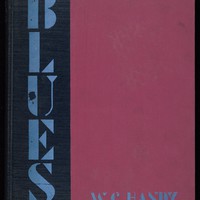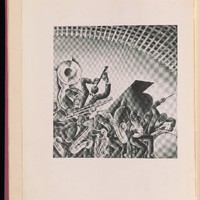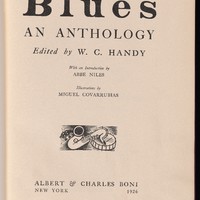Blues: An Anthology
Item
-
Title
-
Blues: An Anthology
-
This edition
-
"The Blues: An Anthology." Ed. W. C. Handy. Intro. Abbe Niles. Illus. Miguel Covarrubias. New York: Albert and Charles Boni, 1926.
-
Reviews and notices of anthology
-
● Johnson, Guy B. "Social Forces" 5.3 (1927): 539-40.
-
"The blues present the unique spectacles of a form of Negro folk song becoming the most important single type of popular song in America. Every people has its melancholy songs, but the Negro blues are in a class to themselves. Their plaintiveness, their humor, and their music have saved them from the graveyard of most folk songs.
"About 1910, W. C. Handy, a Memphis Negro who had unusual musical talent and an appreciative ear for folk tunes, began making popular songs from the fragments of these elusive folk blues. Beginning with 'Memphis Blues,' which is still a favorite, he has continued to the present day to interpret the blues. Lately a host of white as well as colored musicians have been exploiting the blues, but unfortunately very few of them have anything like Handy's ability to develop folk themes into popular themes and still keep the real blues flavor in both words and music. The fact is, about two-thirds of the modern blues are not indigo except in title.
"'Blues' begins with an excellent twenty-five page introduction by Abbe Niles. Niles discusses the folk blues as verse and as music, tells how Handy began to cultivate the folk product, how the blues grew, and their influence on modern music. Niles' theory of the 'blue note' will not entirely satisfy those who hold that the thought and not the music is the chief characteristic of the blues, but he has developed it interestingly.
"Next there is a series of notes to the collection of blues. Brief histories of the origin of each song, its relation, if any, to folk songs, etc., are presented here. Then come the words and music of fifty blues selections, ranging from a few nearly pure folk blues collected by Handy to George Gershwin's 'Rhapsody in Blue.'
"While the chief appeal of this book will be to musicians and blues lovers who may now have the cream of the blues in one book suitable for the piano, I am sure that folk song students will also find themselves using it a great deal. The book is bound colorfully and is uniquely illustrated by Covarrubias.
"Other evidence that the blues have lately begun to attract the attention of students of folk song and of Negro art will be found in the articles by Carl Van Vechten in 'Vanity Fair,' August, 1925, and March, 1926; Miss Scarborough's Chapter [sic] on the blues in her 'On the Trail of Negro Folk Songs'; and Chapter II of Odum and Johnson's 'Negro Workaday Songs'."
-
Item Number
-
A0485





